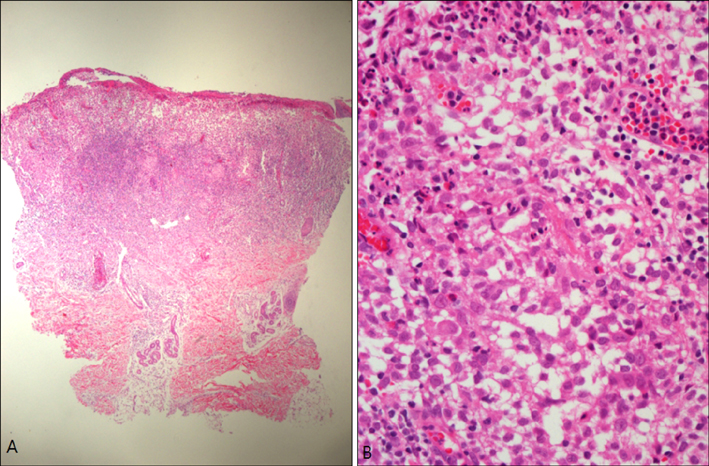Ann Dermatol.
2014 Apr;26(2):250-253. 10.5021/ad.2014.26.2.250.
Solitary Congenital Erosion in a Newborn: Report of a Solitary Congenital Self-Healing Reticulohistiocytosis
- Affiliations
-
- 1Department of Dermatology, St. Paul's Hospital, School of Medicine, The Catholic University of Korea, Seoul, Korea. johnkang@catholic.ac.kr
- KMID: 2171664
- DOI: http://doi.org/10.5021/ad.2014.26.2.250
Abstract
- Congenital self-healing reticulohistiocytosis (CSHRH) is a rare, cutaneous, self-limited form of Langerhans cell histiocytosis. Whereas multiple lesions are common, a solitary lesion is rare. A 14-day-old neonate presented with a solitary, 5-mm, oval, reddish, and eroded papule with crust on the left thigh that had existed since birth. No systemic involvement was found. Histopathology revealed dense infiltration of large histiocytes with scattered eosinophils and lymphocytes in the dermis. Immunohistochemistry showed S-100 and CD1a positivity. Two months later, the skin lesion involuted spontaneously, without evidence of recurrence and extracutaneous involvement. On the basis of the characteristic clinical course and typical histopathological findings, a diagnosis of solitary CSHRH was made.
MeSH Terms
Figure
Reference
-
1. Hashimoto K, Pritzker MS. Electron microscopic study of reticulohistiocytoma. An unusual case of congenital, self-healing reticulohistiocytosis. Arch Dermatol. 1973; 107:263–270.
Article2. Shin N, Kang MJ, Cho S, Whang KK, Hahm JH. A case of congenital self-healing reticulohistiocytosis. Ann Dermatol. 2000; 12:193–196.
Article3. Berger TG, Lane AT, Headington JT, Hartmann K, Burrish G, Levin MW, et al. A solitary variant of congenital self-healing reticulohistiocytosis: solitary Hashimoto-Pritzker disease. Pediatr Dermatol. 1986; 3:230–236.
Article4. Chun SI, Song MS. Congenital self-healing reticulohistiocytosis--report of a case of the solitary type and review of the literature. Yonsei Med J. 1992; 33:194–198.
Article5. Shin MS, Park HJ, Choi YJ, Park MY. A case of a solitary type of congenital self-healing reticulohistiocytosis. Korean J Dermatol. 2008; 46:411–413.6. Writing Group of the Histiocyte Society. Histiocytosis syndromes in children. Lancet. 1987; 329:208–209.7. Ersoy-Evans S, Gursoy T, Yigit S, Akcoren Z, Sahin S. Solitary congenital self-healing reticulohistiocytosis in monozygotic twins. Pediatr Dermatol. 2006; 23:273–275.
Article8. Zunino-Goutorbe C, Eschard C, Durlach A, Bernard P. Congenital solitary histiocytoma: a variant of Hashimoto-Pritzker histiocytosis. A retrospective study of 8 cases. Dermatology. 2008; 216:118–124.
Article9. Bernstein EF, Resnik KS, Loose JH, Halcin C, Kauh YC. Solitary congenital self-healing reticulohistiocytosis. Br J Dermatol. 1993; 129:449–454.
Article10. Masouyé I, Chavaz P, Salomon D, Balderer J, Carraux P, Saurat JH. Solitary Langerhans cell histiocytoma: an unusual form of Hashimoto-Pritzker histiocytosis? Pediatr Dermatol. 1990; 7:299–302.
Article11. Jensen ML, Bygum A, Clemmensen O, Fenger-Gron J. Congenital self-healing reticulohistiocytosis - an important diagnostic challenge. Acta Paediatr. 2011; 100:784–786.
Article12. Dorjsuren G, Kim HJ, Jung JY, Bae BG, Lee JH. Solitary type of congenital self-healing reticulohistiocytosis. Ann Dermatol. 2011; 23:Suppl 1. S4–S7.
Article13. Satter EK, High WA. Langerhans cell histiocytosis: a case report and summary of the current recommendations of the Histiocyte Society. Dermatol Online J. 2008; 14:3.
Article
- Full Text Links
- Actions
-
Cited
- CITED
-
- Close
- Share
- Similar articles
-
- Solitary Type of Congenital Self-healing Reticulohistiocytosis
- Congenital self-healing reticulohistiocytosis: report of a case of the solitary type and review of the literature
- A Case of a Solitary Type of Congenital Self-healing Reticulohistiocytosis
- Congenital self-healing Reticulohistiocytosis
- A Case of Congenital Self-Healing Reticulohistiocytosis Presenting as Erythematous Erosive Patches and Vesicles




